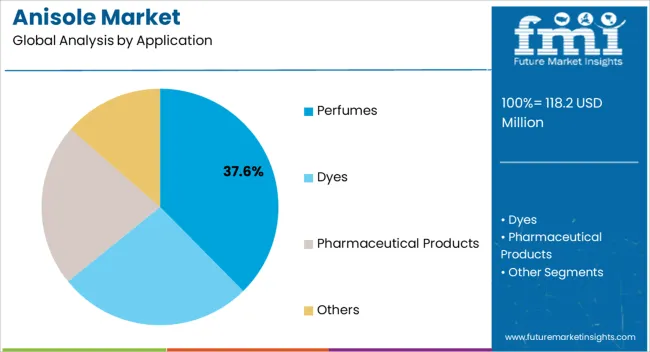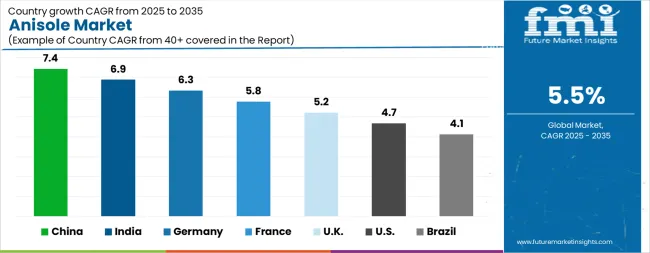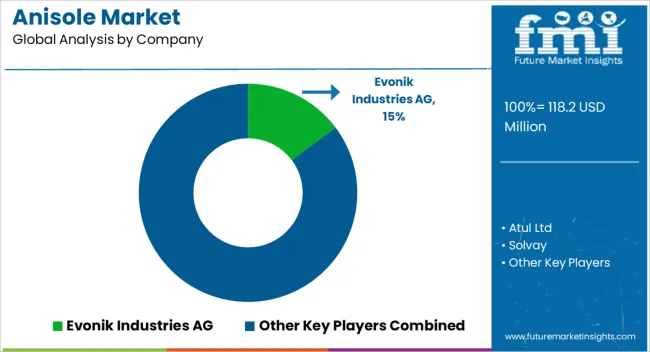The Anisole Market is estimated to be valued at USD 118.2 million in 2025 and is projected to reach USD 201.8 million by 2035, registering a compound annual growth rate (CAGR) of 5.5% over the forecast period.

| Metric | Value |
|---|---|
| Anisole Market Estimated Value in (2025 E) | USD 118.2 million |
| Anisole Market Forecast Value in (2035 F) | USD 201.8 million |
| Forecast CAGR (2025 to 2035) | 5.5% |
The Anisole market is experiencing significant growth driven by its increasing demand across fragrance, pharmaceutical, and chemical industries. Rising consumer preference for perfumery and scented products has heightened the use of Anisole as a key aromatic compound, due to its versatility and strong olfactory characteristics. Growth is further being supported by the expanding cosmetics and personal care sector, which is placing emphasis on high-quality raw materials that enhance fragrance profiles.
Continuous innovation in synthetic and natural formulations is enabling Anisole to be applied in diverse products, providing consistent scent delivery and stability. Industrial investment in research and development is fostering advanced production techniques that improve yield, purity, and environmental compliance.
Regulatory focus on safety and sustainable sourcing is shaping product standards and ensuring responsible manufacturing As global demand for scented consumer goods increases, the Anisole market is positioned for steady expansion, driven by innovations in application methods, rising consumer awareness, and integration into high-demand end-use industries, paving the way for long-term market growth opportunities.
The anisole market is segmented by application, and geographic regions. By application, anisole market is divided into Perfumes, Dyes, Pharmaceutical Products, and Others. Regionally, the anisole industry is classified into North America, Latin America, Western Europe, Eastern Europe, Balkan & Baltic Countries, Russia & Belarus, Central Asia, East Asia, South Asia & Pacific, and the Middle East & Africa.

The perfumes application segment is projected to hold 37.6% of the Anisole market revenue share in 2025, making it the leading application category. Its prominence is being driven by the high demand for fragrance compounds that provide desirable olfactory qualities and long-lasting scent profiles in personal care products. Perfume manufacturers are increasingly incorporating Anisole due to its compatibility with a wide range of formulations, including both natural and synthetic blends, enabling consistent performance and enhanced consumer appeal.
The segment is also being supported by growing global consumption of premium and mass-market fragrances, as rising disposable incomes and lifestyle-driven spending increase adoption. Advances in extraction and synthesis technologies have allowed producers to deliver higher purity Anisole at competitive costs, improving supply chain efficiency and product quality.
Regulatory compliance and sustainability considerations are being addressed through controlled sourcing and production practices The flexibility of Anisole to be utilized across multiple perfume applications, combined with its proven efficacy in enhancing scent characteristics, has reinforced its leadership position and is expected to continue driving segment growth in the coming years.
The demand growth is attributed to the increasing consumer focus on self-care, leading to a rise in demand for anisole, a key ingredient in many cosmetic products. The forthcoming decade is expected to witness a significant surge in demand for anisole as it continues to be prominently featured in various cosmetic formulations.
The market is fueled by a confluence of positive factors. Stringent regulations governing the production of pharmaceutical-grade materials are a key driver. These regulations demand high purity and safety standards, which anisole readily meets. This, in turn, is expected to propel the demand for anisole in the production of both internally and externally administered pharmaceuticals.
The industry is expected to benefit from advancements on the technological front. Manufacturers are continuously innovating and refining their processes to achieve superior yields of higher-grade anisole. This increased availability of high-purity anisole will undoubtedly have a positive impact on the anisole market.

| Country | CAGR |
|---|---|
| China | 7.4% |
| India | 6.9% |
| Germany | 6.3% |
| France | 5.8% |
| UK | 5.2% |
| USA | 4.7% |
| Brazil | 4.1% |
The Anisole Market is expected to register a CAGR of 5.5% during the forecast period, exhibiting varied country level momentum. China leads with the highest CAGR of 7.4%, followed by India at 6.9%. Developed markets such as Germany, France, and the UK continue to expand steadily, while the USA is likely to grow at consistent rates. Brazil posts the lowest CAGR at 4.1%, yet still underscores a broadly positive trajectory for the global Anisole Market. In 2024, Germany held a dominant revenue in the Western Europe market and is expected to grow with a CAGR of 6.3%. The USA Anisole Market is estimated to be valued at USD 41.0 million in 2025 and is anticipated to reach a valuation of USD 64.7 million by 2035. Sales are projected to rise at a CAGR of 4.7% over the forecast period between 2025 and 2035. While Japan and South Korea markets are estimated to be valued at USD 5.7 million and USD 3.2 million respectively in 2025.

| Item | Value |
|---|---|
| Quantitative Units | USD 118.2 Million |
| Application | Perfumes, Dyes, Pharmaceutical Products, and Others |
| Regions Covered | North America, Europe, Asia-Pacific, Latin America, Middle East & Africa |
| Country Covered | United States, Canada, Germany, France, United Kingdom, China, Japan, India, Brazil, South Africa |
| Key Companies Profiled | Evonik Industries AG, Atul Ltd, Solvay, Tokyo Chemical Industry Co., Ltd., SURYA LIFE SCIENCES LTD., Thermo Fisher Scientific, Emmennar Pharma Pvt. Ltd., Benzo Chem Industries Pvt. Ltd., Merck KGaA, and Camlin Fine Sciences Ltd. |
The global anisole market is estimated to be valued at USD 118.2 million in 2025.
The market size for the anisole market is projected to reach USD 201.8 million by 2035.
The anisole market is expected to grow at a 5.5% CAGR between 2025 and 2035.
The key product types in anisole market are perfumes, dyes, pharmaceutical products and others.
In terms of , segment to command 0.0% share in the anisole market in 2025.






Our Research Products

The "Full Research Suite" delivers actionable market intel, deep dives on markets or technologies, so clients act faster, cut risk, and unlock growth.

The Leaderboard benchmarks and ranks top vendors, classifying them as Established Leaders, Leading Challengers, or Disruptors & Challengers.

Locates where complements amplify value and substitutes erode it, forecasting net impact by horizon

We deliver granular, decision-grade intel: market sizing, 5-year forecasts, pricing, adoption, usage, revenue, and operational KPIs—plus competitor tracking, regulation, and value chains—across 60 countries broadly.

Spot the shifts before they hit your P&L. We track inflection points, adoption curves, pricing moves, and ecosystem plays to show where demand is heading, why it is changing, and what to do next across high-growth markets and disruptive tech

Real-time reads of user behavior. We track shifting priorities, perceptions of today’s and next-gen services, and provider experience, then pace how fast tech moves from trial to adoption, blending buyer, consumer, and channel inputs with social signals (#WhySwitch, #UX).

Partner with our analyst team to build a custom report designed around your business priorities. From analysing market trends to assessing competitors or crafting bespoke datasets, we tailor insights to your needs.
Supplier Intelligence
Discovery & Profiling
Capacity & Footprint
Performance & Risk
Compliance & Governance
Commercial Readiness
Who Supplies Whom
Scorecards & Shortlists
Playbooks & Docs
Category Intelligence
Definition & Scope
Demand & Use Cases
Cost Drivers
Market Structure
Supply Chain Map
Trade & Policy
Operating Norms
Deliverables
Buyer Intelligence
Account Basics
Spend & Scope
Procurement Model
Vendor Requirements
Terms & Policies
Entry Strategy
Pain Points & Triggers
Outputs
Pricing Analysis
Benchmarks
Trends
Should-Cost
Indexation
Landed Cost
Commercial Terms
Deliverables
Brand Analysis
Positioning & Value Prop
Share & Presence
Customer Evidence
Go-to-Market
Digital & Reputation
Compliance & Trust
KPIs & Gaps
Outputs
Full Research Suite comprises of:
Market outlook & trends analysis
Interviews & case studies
Strategic recommendations
Vendor profiles & capabilities analysis
5-year forecasts
8 regions and 60+ country-level data splits
Market segment data splits
12 months of continuous data updates
DELIVERED AS:
PDF EXCEL ONLINE
4-Allylanisole Market Size and Share Forecast Outlook 2025 to 2035

Thank you!
You will receive an email from our Business Development Manager. Please be sure to check your SPAM/JUNK folder too.
Chat With
MaRIA